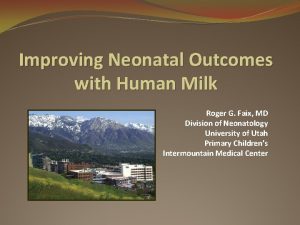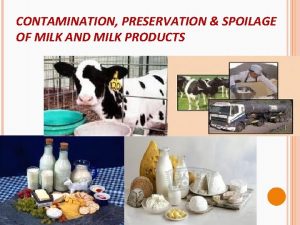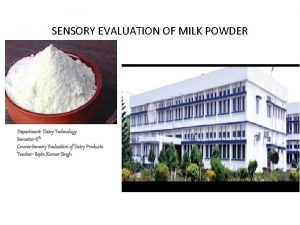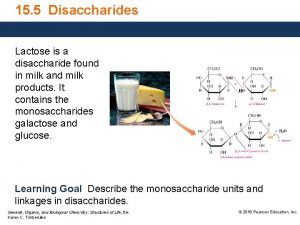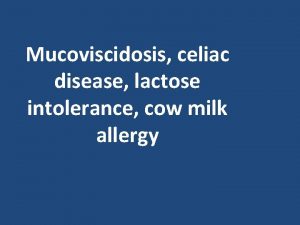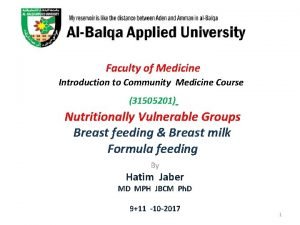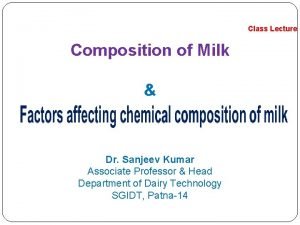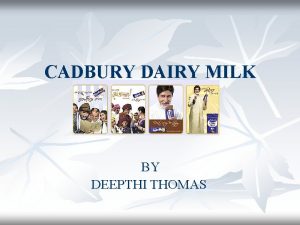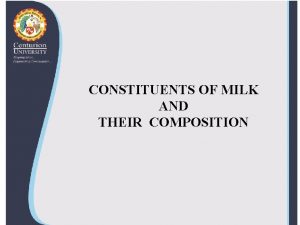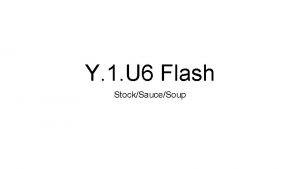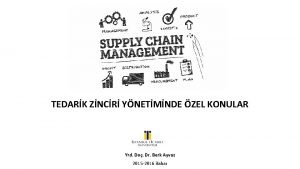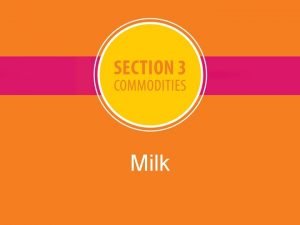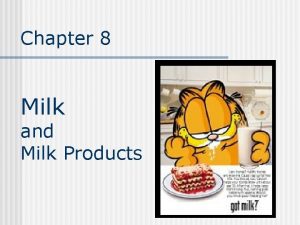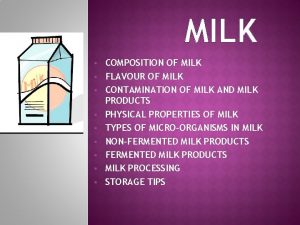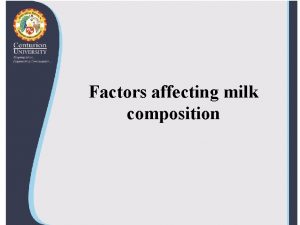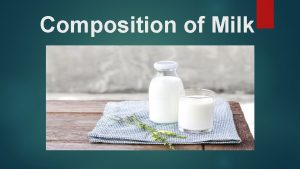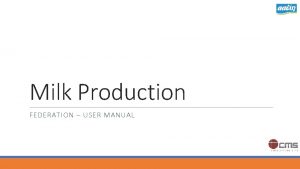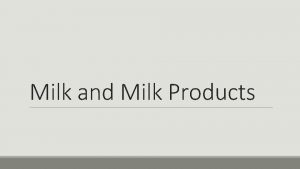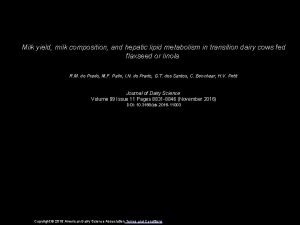Composition of milk Milk is made up of











- Slides: 11


Composition of milk • Milk is made up of over 100 compounds of milk, carbs, protein, lipids and many minerals. Cows milk is the most wide spread milk in the world. Its only considered to be genuine if it contains 3% fat and 8. 5% other solids. The breed, age, stage of lactation, season, feed, time and period between milking will effect the composition of the milk. • The breed is the most important single factor. Disease and temperature also effect the milk. In warmer climates milk yield falls enormously and its composition may alter.

Composition of milk continued • Milk is mainly water. • The lipid content of milk is mainly fat (buttermilk) with small amounts of phospholipids, sterols, carotenoids and Vitamin A and D. The fat occurs in globules which are stabilised by the milk fat globule membrane. • 3. 3% is protein

Milk proteins - Caseins • Although only 3. 3% of milk is protein 82% of those proteins are casein. • Casein (curd precipitated by acid or the enzyme renin). It is a mixture of phosphoproteins (ie proteins which contain phosphate groups) this totals 2. 5 – 3. 2% of the whole milk. Casein coagulate at p. H 4. 6 so they precipitate out when the milk is acidified (cheese making). • There are two types of casein α (alpha) and κ (kappa). α -casein is coagulated by calcium ions and κ -casein is insensitive to calcium. Casein exist in micelles (think of them as smarties) The α -casein is on the inside (chocolate) and the κ -casein is on the outside (the hard shell). The κ -casein can be damaged by heat, enzymes and acid which means that the calcium sensitive alpha casein precipitates and forms a curd. The protein remaining after casein has been precipitates from the milk is known as whey. •

Milk proteins – Whey • The whey proteins are soluble at p. H 4. 6, they don’t contain phosphorus but do have lots of sulphur. These denature during yoghurt making and the proteins can then hold more water which gives the texture of water. • The main whey proteins are α – lactalbumin and lactoglobulin which is associated with enzymes responsible for lactose synthesis. • Whey is a by-product of the cheese industry and is used widely to add bulk, stick flavourings onto crisps, hold water, glue things together such as stick cubes and used in protein shakes.

Lactose • This disaccharide is only found in milk. After concentrating milk by evaporating some of the water it contains a large amount of sugar (sucrose) is added to preserve the product. Lactose content along with protein composition varies with cow breed. Lacto free milk is treated with enzymes to remove the lactose. In cheese production the lactobacillus are feeding on the lactose and converts it to lactic acid, so cheese contains less lactose than milk does.

Homogenisation recap • http: //www. bbc. co. uk/education/clips/z 7 bx pv 4

What are curds and whey? Curds- the solid lumps you find in milk when milk sours. You can treat milk with enzymes to get the same effect Whey- The watery liquid that you find in milk when the milk sours / is treated with enzymes

You can add a starter culture with rennet to milk to get curds and whey Why would anybody WANT to make curds and whey? Curds can be used to make cheese Whey can be used as animal feed

Cheese Add salt to curds- you get cheese! The cheese needs to be pressed Crumbly cheeses (e. g. Wensleydale) are only pressed lightly Hard cheeses (e. g. Cheddar) are pressed firmly The cheese is then left to mature (to develop flavour and texture)

1. Take milk; add rennet and a starter culture to it 2. The milk curdles 3. You now have curds and whey. 4. Drain the whey to leave only the curds 5. Add salt to the curds 6. Press the curds into moulds 7. Leave to mature 8. Package
 Milkbankcolorado
Milkbankcolorado Contamination of milk and milk products
Contamination of milk and milk products Sensory evaluation of dairy products
Sensory evaluation of dairy products Lactose is a disaccharide found in milk
Lactose is a disaccharide found in milk Milk for toddlers with milk allergynon dairy
Milk for toddlers with milk allergynon dairy Human milk vs cow milk
Human milk vs cow milk Composition of milk
Composition of milk Milk yield and composition in dairy cows ppt
Milk yield and composition in dairy cows ppt Composition of milk
Composition of milk A highly flavored stock made with fish bones
A highly flavored stock made with fish bones 1 gallon of milk weighs
1 gallon of milk weighs Milk run taşıma
Milk run taşıma
